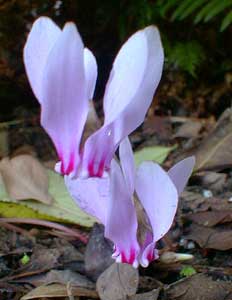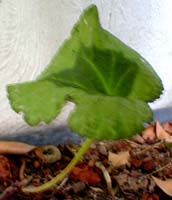
Wild Persian Violet Cyclamen
"Would you prefer myrrh-flower or cyclamen?
I have them, I could spread them out again;
but now for this stark moment while Love breathes
his tentative breath, as dying, yet still lives."
-H.D.
(1886-1961)
(1886-1961)
Besides the bright red-red florist's cyclamen C. persicum 'Laser Scarlet' which has done about halfway well as an outdoor plant for us, we planted other patches of C. persicums that are wild & completely non-hybridized. These have the normal species color of pale violet, & are so similar to hardy cyclamens in appearance it is hard to see in them the ancestry of delicate florist's cyclamens.
Those in our garden were grown from tubers. One was planted at the foot of an espalliered autumn-blooming Camella sansanqua & it never showed itself the first year even a little, so I thought it may have died. But I kept the spot marked in case the tuber was alive & eventually recovered from the abusive way they are gathered, dried, stored, shipped, & packaged. Sure enough, it produced leaves, but no flowers, beginning the tail end of October of its second year.
Two more tubers were planted near the foot of an akebia arbor where they are overshadowed by the huge leaves of our locally native swordfern. Of these two tubers, neither showed itself the first year. One bloomed very nicely in the first week of October in its second autumn prior to producing any leaves. The third showed its first flower buds at the end of October, comparatively weak & timid, just enough to assure us it wasn't dead. The lack of uniformity of behavior seems to be common intra-species for all cyclamens, but starting with stressed tubers rather than healthy seedlings is part of the reason for these.
I did not realize when I bought these large tubers that they are all stolen from the wild, & I assuredly felt rather guilty about it when I became more of a cyclamen fanatic collecting a great many of them as nursery-grown only. Nursery-grown specimens are typically sold as two or three year seedlings; it takes many years to become a four-inch round one-inch flat tuber. Though one might like to believe an old tuber will establish faster & bloom better in the garden, in fact they rarely do so, because cyclamen tubers first of all hugely dislike being dug up, second of all do not store well for any length of time, & third, they utterly deplore being permitted to dry out as is required for the semi-criminal tuber market to package & ship them for retail.
These stressed & often ruined tubers can take two or three years to start doing anything at all, & all too frequently simply rot away never showing themselves in the least. This is true not only of the comparatively delicate C. persicum but also of the hardiest C. coum & C. hederifolium tubers. By contrast, when hardy cyclamens are obtained as two-year seedlings, they generally bloom the first year in the garden, & become increasingly wonderful every year thereafter. They're also occasionally offered more expensively as older pot-grown specimens, & do ever so much better than from tubers that were damaged, dried, & stored before market. So the fact is, even if a gardener were to act out of the most selfish & ecologically careless desire for instant gratification, there's no personal benefit to buying tubers snatched from the wild since selected nursery-grown cultivars are superior in every regard & perform sooner.
Putting such severe pressures on natural populations by purchasing tubers has placed cyclamens at risk of extinction in many parts of their wide range. Once I learned that all such large tubers are stolen from the wild, I knew I'd never buy them again, but would only be adding nursery-grown varieties to our gardens in the future. Cultivated forms are more varied & wonderful in any case. But since I had already mistakenly obtained three wild tubers for C. persicum & three more allegedly of C. coum, I tried to take the best possible care of them.
Of the ultra-hardy C. coum one of the tubers arrived already blackened, shriveled, smelly, & dead. Of the other two, one turned out to be Cyclamen hederofolium, not that I minded, but it is another lesson on how crooked are the thieves who snatch plants from the wild. They'll sell tubers not merely stolen from the wild, but dead or mislabeled.
Of the three C. persicum tubers, only one thus far has performed really well. Tubers do often surprise a body & recover after two or three years later, so even though they all seemed dead the first year, I did not disrupt them & in their second year all three tubers turned out to be alive, though it would take a third year before all three performed nicely. I must underscore the fact that nursery-grown seedling perform much more rapidly in the garden than tubers that have undergone so many varied stresses & have trouble recovering.
The one C. persicum tuber that produced the most flowers in its second autumn was a lovely thing to behold. The wild form though tender is even so vastly hardier than the the gaudiest C. persicum florist cultivars with gigantic blossoms or gigantic leaves, which cannot survive temperate weather. But the natural wild form can usually bear up to short-term frosts when they have to. The one shown in the above photo bloomed for us throughout the whole of October, before leaves were out, shortly after C. hederifolium was blooming, but well before C. coum. Though the non-bloomer under the cyclamen produced leaves late in October, the two that bloomed waited until November to produce leaves.
Even though cultivated C. persicum varieties are so extravagant, for the basic wild form the flowers are not noticeably different from those of C. hederifolium & C. coum. And because they do look so similar, but are more at risk if frosts last longer than a couple days, it is a little silly to add C. persicum to a Zone 8 garden at all, as even Puget Sound's mild micro-climate is apt to leave the Persian frost-damaged even if not actually killed. By comparison, such species as C. coum, C. hederifolium, C. cilicium, C. purpurascens, & the teency C. parviflorum are truly frost-hardy autumn & winter bloomers, hence far better choices for the garden. If I had it to do over knowing what I later learned, I might still plant a few C. persicums in extremely sheltered locations, but probably only specimens locally nursery-grown & so familiar from the start with our weather patterns. It's a short drive to Heronswood Nursery which has been producing strong seedlings of a wild strain for local gardens. But again, as it does look so similar to the hardiest species, it is smarter to stick to the hardiest, & we've gotten so many remarkable ultra-hardies from Heronswood & other local growers that we keep passing on further C. persicums.
C. persicum prefers part shade/part sun, but will tolerate full shade. It will not survive extremes of heat or cold. In zone 8 it needs at the very least an overhanging shrub or eaves as winter protection. Below zone 8, it will much more certainly die in winter. In Zone 9 or 10, it will be a more appropriate garden plant. Still, in a protected location, the wild form can do pretty well in our zone, & if it is not injured by winter frosts the first two years, it'll likely be safe thereafter.
A few end-notes on the ultra-fancy cultivars of C. persicum are in order, though they are not at all recommended for temperate gardens. These range from miniature blooms to enormous blooms, from normal-sized cyclamen leaves to leaves so big they almost evoke cabbages. The fanciest & largest cultivars sold as winter houseplants can get to be 14 inches tall. None of those big ones will ever do well outdoors in our area, & are not often good garden plants even in zones that are warm enough for them to survive, as many hothouse tricks are played with them to get that big perfect look for the winter market when they are sold even in grocery stores. In the long run, they barely do well even indoors & to get them to rebloom can take such a special talent, or end up such a drudgery, that most people discard them after their fresh-bought flowery flourish is completed.
 Nevertheless, when a local retailer was discarding the dead-looking remnants of the fancy cultivars they'd stocked for their houseplant section, one of these was handed to me as a freebie, & I stuck it in the ground amidst hardy cyclamens but farthest back under eaves where it would experience very protected dry shade. It never bloomed, but each late-summer & autumn it produces a few large lime-green leaves. For the heck of it, I am showing one of these leaves here. It has never yet had more than about six leaves at a time, often only one leaf at a time, & at first hint of winter it vanishes until the next late summer or early autumn. Its long thick stems easily break off; so in all, it's no great shakes even for foliage, but it hangs on to life, & when the occasional leaf is nearly six inches large, I do get a charge out of seeing it.
Nevertheless, when a local retailer was discarding the dead-looking remnants of the fancy cultivars they'd stocked for their houseplant section, one of these was handed to me as a freebie, & I stuck it in the ground amidst hardy cyclamens but farthest back under eaves where it would experience very protected dry shade. It never bloomed, but each late-summer & autumn it produces a few large lime-green leaves. For the heck of it, I am showing one of these leaves here. It has never yet had more than about six leaves at a time, often only one leaf at a time, & at first hint of winter it vanishes until the next late summer or early autumn. Its long thick stems easily break off; so in all, it's no great shakes even for foliage, but it hangs on to life, & when the occasional leaf is nearly six inches large, I do get a charge out of seeing it.As a loose generality, the bigger the leaves & flowers on a C. persicum fancy florist hybrid, the less hardy it will be, & useless for temperate gardening. Although many of the small-flowered persicum cultivars are also too sensitive for a temperate garden, some will survive. But mainly it is the wild form that is somewhat frost tolerant.
A note on planting C. persicum: This is the only species of cyclamen that wants the top surface of its tuber exposed to the air. Unfortunately, in Zone 8, this exposes it all the more to the possibility of being killed by winter frosts, so in our zone it is better to bury it just a hair below the surface. This may stunt it a little, but it will adapt. In Zone 9 or 10 it would properly be buried less than two-thirds into the ground with most or all the top surface visible.
As a closing footnote, cyclamens are poisonous & no part of them should ever be eaten. One would suppose C. persicum would be more vulnerable to discovery by animals since it likes to have the smooth top surface of the tuber exposed. But squirrels & other animals that are sometimes tempted by bulbs always leave cyclamen tubers be.
Continue to
Cyclamen persicum 'Laser Scarlet'